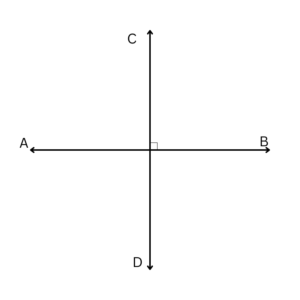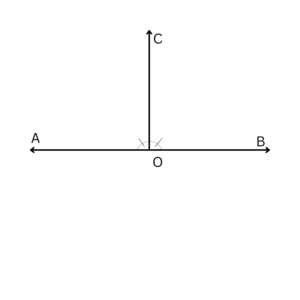Introduction
A straight line that intersects another straight line at a 90-degree angle is said to be perpendicular to the first line. The small square in the middle of two perpendicular lines in the figure represents 90 degrees, also known as a right angle. Here, two lines cross at a right angle, indicating that they are perpendicular to one another.
In contrast to sloping or horizontal lines or surfaces, perpendicular lines or surfaces point directly upward. An object is at a 90-degree angle to another if it is perpendicular to it. A pair of lines, vectors, planes, or other objects are said to be perpendicular if they intersect at a right angle. Two vectors ![]() are perpendicular if their dot product equals zero.
are perpendicular if their dot product equals zero.
Perpendiculars
When two lines intersect at a right angle, they are said to be perpendicular to one another. A first line is perpendicular to a second line, more specifically, if the two lines intersect and the straight angle on one side of the first line is split into two congruent angles by the second line at the intersection. Since perpendicularity is symmetric, if one line is perpendicular to another, the other line is also perpendicular to the first. As a result, we don’t need to specify an order when referring to two lines as perpendicular (to one another).

Perpendicular Lines
Segments and rays are easily extended by perpendicularity. If a line segment AB and a line segment CD result in an infinite line when both directions are extended, then the two resulting lines are perpendicular in the sense mentioned above. Line segment AB is perpendicular to line segment CD and can be represented by the symbol AB ⊥ CD. If a line crosses every other line in a plane, it is said to be perpendicular to the plane. The definition of line perpendicularity is necessary for understanding this definition.

Perpendicular Theorem
According to the perpendicular line theorem, two straight lines are perpendicular to one another if they intersect at a point and create a pair of equal linear angles.
Assume two lines AB and CD intersect each other at O, such that ∠AOC = ∠COB, also since AB is a line, ∠AOC and ∠COB also form a linear pair.

Then, ∠AOC + ∠COB = 180°
Using ∠COB = ∠AOC
⇒ ∠AOC + ∠AOC = 180°
⇒ 2 ∠AOC = 180°
⇒ ∠AOC = 90°
Thus, since the angle of intersection is 90°, we can say that AB is perpendicular to CD and vice versa.
Also Read: Related Angles
Perpendicularity: Slope Formula
Perpendicularity is known as the mathematical condition that two lines need to satisfy to be called perpendicular. Mathematically, if two lines are perpendicular to each other, then the product of their slopes is negative unity.
For example, let two lines of slope ![]() . Then these lines are said to be perpendiculars to one another if their slopes have a product -1, i.e.,
. Then these lines are said to be perpendiculars to one another if their slopes have a product -1, i.e., ![]()
Equation of a Perpendicular Line.
Using the conditions from previous sections, we can find the equation of the perpendicular line to any given line’s equation, at a certain point.
Let, ax + by = c be a line, and we need to find a line perpendicular to it passing through ![]()
First, we will find the slope of the given line,
Slope of a line m = -a/b
Now, using perpendicularity, if the slope of the second line is m’, then for these lines to be perpendicular
m × m’=- 1
⇒ m’ =- 1/m =- 1/-a/b = b/a
Thus, the slope of the perpendicular line is,
m’= b/a
Then, we have a point as well as the slope for the equation of the perpendicular line,
Using point-slope form

If we know the exact values of a, b and ![]() then we can further simplify this equation.
then we can further simplify this equation.
Interesting Facts about Perpendicular Lines
- In order to obtain the maximum support for the roof, walls and pillars are constructed perpendicular to the ground in our homes and other buildings. This is just one example of how perpendiculars are used in everyday life.
- Perpendiculars of two lines that meet at an angle will also meet at that same angle.
Solved Examples
Example: Which of the following pair of lines are perpendicular, parallel, or simply intersecting?

- Intersecting, since the angle of intersection here is given to be 100 degrees.
- Perpendicular, as we know the right angle is also represented by a small square, we can say that these lines are perpendicular to each other.
- Parallel lines, clearly extending these lines to infinity we will never see them intersecting; thus, they are parallel.
- Perpendicular, clearly the angle of intersection here is given to be 90 degrees.
Summary
The subject of perpendiculars and the perpendicularity of lines were covered in this article. The reader should be able to comprehend the meaning of perpendicular lines, the symbol used to represent them, as well as the formula and theorems relating to perpendicular lines, after carefully reading this article. Two lines are said to be perpendicular if their angle of intersection is a right angle. The slopes of perpendicular lines are negative reciprocals of each other.
Frequently Asked Questions (FAQs)
1.What are Perpendicular Lines?
Ans. When two lines intersect at an angle of 90 degrees, the lines are said to be perpendicular to each other.
2. How do you Find the Slope of a line Perpendicular to a Given Line?
Ans. The slope of perpendicular lines are negative reciprocals of each other; thus, the slope of a perpendicular line can be found simply by negating the reciprocal of the slope of the given line.
3. What are Perpendicular Bisectors?
Ans. A line that divides another line segment into two halves while also being at a right angle to it is known as the perpendicular bisector of the line segment.
4. Are all Intersecting Lines Perpendicular?
Ans. No, all intersecting lines are not perpendicular, but all perpendicular lines are intersecting, that too at a specific angle, i.e., 90 degree.
Also read: Properties, Area of Right-Angled Triangles




